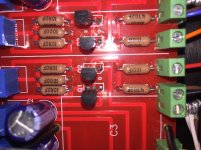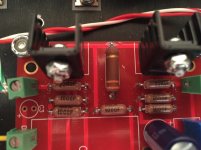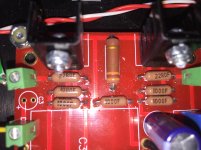Its correct method of elimination thinking. Because there could be some mistaken restrictive current limit programmed in the PSU CCS.Just thought of something. I never checked the supply rails while the preamp had a signal on it. Will do that when I get home.
Just thought of something. I never checked the supply rails while the preamp had a signal on it. Will do that when I get home.
Checked before and after 10 minute warm up. Offset was up to 12Vdc. Supply rails are all rock solid at ~24Vdc give or take a couple mV.
I'm confused. You say the DC offset is drifting over time? I thought it was solid?
Let's talk about just DC, not ac output levels...when the amp is cold you have 0 offset, right? When it's hot what is your offset? 16v dc? Is that what you are saying? Test this with no source, volume knob at min. And inputs shorted.
If you have 0 offset when cold and 16v dc when hot under these conditions you either have fake jfets or mosfets (btw, what is your bias levels?) a bad joint or wrong resistor value or....here it comes...not enough heat sink on the mosfets (are they too hot to touch?) because that shunt reg is putting out a lot of heat right next to the output mosfet of the ba3. The salas shunt is awesome...I use them too but they run hotter than a lm317 or whatever reg. The shunt heats up, changes the balance between the output mosfets of your ba3 and creates a high dc offset. I would (as a test) lower the ba3 bias to say .75v, and see if the offset is more stable. Also, I would get some bigger sinks and try that. Another test would be to 0 the dc after 2 hours (after its nice and hot) and then put you fingers on the ba3 output mosfets if it's not too hot. I bet the Dc will drift. Also, if you don't know, don't "bridge" the two mosfets with a single sink without insulating them from the sink if you go to a bigger sink.
Let's talk about just DC, not ac output levels...when the amp is cold you have 0 offset, right? When it's hot what is your offset? 16v dc? Is that what you are saying? Test this with no source, volume knob at min. And inputs shorted.
If you have 0 offset when cold and 16v dc when hot under these conditions you either have fake jfets or mosfets (btw, what is your bias levels?) a bad joint or wrong resistor value or....here it comes...not enough heat sink on the mosfets (are they too hot to touch?) because that shunt reg is putting out a lot of heat right next to the output mosfet of the ba3. The salas shunt is awesome...I use them too but they run hotter than a lm317 or whatever reg. The shunt heats up, changes the balance between the output mosfets of your ba3 and creates a high dc offset. I would (as a test) lower the ba3 bias to say .75v, and see if the offset is more stable. Also, I would get some bigger sinks and try that. Another test would be to 0 the dc after 2 hours (after its nice and hot) and then put you fingers on the ba3 output mosfets if it's not too hot. I bet the Dc will drift. Also, if you don't know, don't "bridge" the two mosfets with a single sink without insulating them from the sink if you go to a bigger sink.
He sinks the shunt regs MOSFETS at the big box's (3mm thick?) floor plate as we see in his photos when the BA-3 MOSFETS are on small board-level sinks on a higher plane while the top lid is open. Sounds like a rather bold hypothesis that high surrounding heat is kicking semis so much out of correct bias territory. I would buy the fake semis, build mistake, or passive parts wrong values hypothesis more easier. High heat is easily felt, so if he will make a simple inspection he will enlighten us.
He sinks the shunt regs MOSFETS at the big box's (3mm thick?) floor plate as we see in his photos when the BA-3 MOSFETS are on small board-level sinks on a higher plane while the top lid is open. Sounds like a rather bold hypothesis that high surrounding heat is kicking semis so much out of correct bias territory. I would buy the fake semis, build mistake, or passive parts wrong values hypothesis more easier. High heat is easily felt, so if he will make a simple inspection he will enlighten us.
Salas, You are probably right (and way smarter than I am for sure). I mean bigger sinks for the ba3, not the shunt. It's not the shunts problem. On my ba3 I have also had this problem with the heat sink of a super reg right next to one output of the ba3. The drift was way less severe ( less than a volt). Could be a bad joint that doesn't show up until it heats up?
Last edited:
Nobody is smarter, we are just more knowledgeable in things we happen to have more experience. In the case of BA-3 as preamp you are de facto more knowledgeable than me because you simply had made one when I had only listened to one for half an hour a year ago.
So we just think of scenarios and I don't see reasons for great amounts of radiated heat from the shunts on the BA-3 sinks based on the photos. I also don't think that a Class A amp's front end (as designed originally for) would ever be so much heat drift sensitive, so to can live in a high dissipation amplifier's box.
Thus I suspect bad or fake semis as more likely if the enormous DC drift reported is accurate
So we just think of scenarios and I don't see reasons for great amounts of radiated heat from the shunts on the BA-3 sinks based on the photos. I also don't think that a Class A amp's front end (as designed originally for) would ever be so much heat drift sensitive, so to can live in a high dissipation amplifier's box.
Thus I suspect bad or fake semis as more likely if the enormous DC drift reported is accurate
P.S. Now I saw your bigger sinks on BA-3 argument. Yes that one is valid if those sinks are having >55C after warm up. At 45mA & 24V each one semi dissipates 1.08W and the situation must be inspected.
Nobody is smarter, we are just more knowledgeable in things we happen to have more experience. In the case of BA-3 as preamp you are de facto more knowledgeable than me because you simply had made one when I had only listened to one for half an hour a year ago.
So we just think of scenarios and I don't see reasons for great amounts of radiated heat from the shunts on the BA-3 sinks based on the photos. I also don't think that a Class A amp's front end (as designed originally for) would ever be so much heat drift sensitive, so to can live in a high dissipation amplifier's box.
Thus I suspect bad or fake semis as more likely if the enormous DC drift reported is accurate
Trust me, you are way smarter than me. I've been building your designs for years! I thank you every time I Use my turntable. You are not only a good designer but a great teacher and more than generous.
It's worth checking for heat related bias/offset instability. Those sinks on the ba3 look small. That being said, we always tend to go with the explanation we have experience with and it could be a lot of things ( such as fake 170/74) or fake/bad Mosfets.
temperatures:
Right channel - no input signal
Q3 48C
Q4 48C
Left channel - 1V p-p input
Q3 47C
Q4 56C
Right channel - no input signal
Q3 48C
Q4 48C
Left channel - 1V p-p input
Q3 47C
Q4 56C
Also, are R13's 330 Ohm confirmed? I mean when power is off what the Ohm meter shows across each?
So they all work alike. Are all R10 R11 drops normal (~1V)?
I've tested the drops on R10 and R11 before and they're stable at 1V until I put a signal on the input, then they go wacky. I can't re-test them right now as I've taken the board out of the preamp for inspection.
Also, are R13's 330 Ohm confirmed? I mean when power is off what the Ohm meter shows across each?
R13 are tested as 330ohm
Do both channels have unstable dc offset or just one?
Both channels act exactly the same.
- Home
- Amplifiers
- Pass Labs
- BA-3 As Preamp



